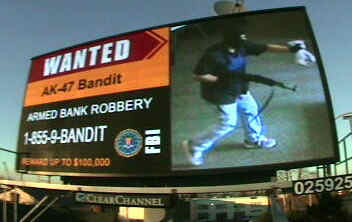How FBI Uses Digital Billboards to Catch Fugitives
The U.S. Federal Bureau of Investigation (FBI) is leveraging its digital billboard initiative effectively to catch fugitives in the current information age.
In April 2013, according to FBI, a Buffalo grand jury indicted 33-year-old Oscar Romero and other suspected members of the Loiza Boys gang, charging them with heroin and cocaine distribution.
After nearly a year on the run, investigators received information that Romero had returned to the Buffalo area from Puerto Rico, and the FBI deployed a powerful weapon to help capture the fugitive—digital billboards.
The electronic billboards featuring Romero’s face—along with the words “Wanted” and “Drug Charges” and a number to call—were posted in the Buffalo area on March 31, 2014. Four days later, Romero turned himself in.
[ Also Meet: President Obama’s Task Force on 21st Century Policing ]
“When our billboards went live, Oscar Romero had been a federal fugitive for just shy of a year,” said Brian Boetig, special agent in charge of the FBI’s Buffalo Division. “Our partnership with the local billboard company generated media attention and conversations throughout Romero’s West Side neighborhood, which pressured him into safely surrendering.”
Similar events have occurred around the country, thanks to the FBI’s National Digital Billboard Initiative, which began in 2007 in Philadelphia when a graduate of the FBI’s Citizens Academy—who happened to be an executive with Clear Channel Outdoor—offered to provide free space on the company’s digital billboards to help catch criminals and rescue missing children.
[ Do You Recognize This Man? Asks FBI ]
Since then, according to FBI, the program has recorded impressive growth—and results. To date, the FBI has captured 53 individuals as a direct result of billboard publicity, and the Bureau now has access to more than 5,200 billboards nationwide made available by a number of companies.
The billboard initiative is an excellent example of how law enforcement, the private sector, and the public can all work together to bring criminals to justice in today’s information age, says FBI.
“We view the partnership with the FBI as a model of public service,” said Nancy Fletcher, president and CEO of the Outdoor Advertising Association of America (OAAA). “The billboard program makes a difference, using the latest technology on behalf of public safety.”
The FBI has formal partnerships with OAAA, Clear Channel Outdoor, Lamar Advertising Company, Outfront Media (formerly CBS Outdoor), Adams Outdoor Advertising, the Fairway Media Group, CEMUSA, and the Outdoor Advertising Association of Georgia.
All these organizations—including other digital advertisers who informally support the program—have been critical to the success of numerous investigative efforts, because digital billboards are extremely effective in reaching the public with information about fugitives, missing persons, and public safety issues.
“The companies’ willingness to assist us in bringing criminals to justice, as well as the speed in which they are able to publicize the information, is a tribute to their organizations,” said Mike Kortan, assistant director for the FBI’s Office of Public Affairs. “Their efforts have given us an added edge to identify, locate, and apprehend fugitives—and that, in turn, has helped to stop many criminals from further victimizing the public.”
Because digital billboards can be quickly changed and updated, information about a kidnapped child, a bank robbery, or a matter of public safety can immediately be displayed. And messages can be targeted to specific geographic locations, which is important when time is of the essence.
And as the program expands, FBI is adding new formats. Fugitive information, for example, is now being displayed on digital bus shelters in Washington, D.C., and digital newsstands in New York City.
Courtesy: FBI











